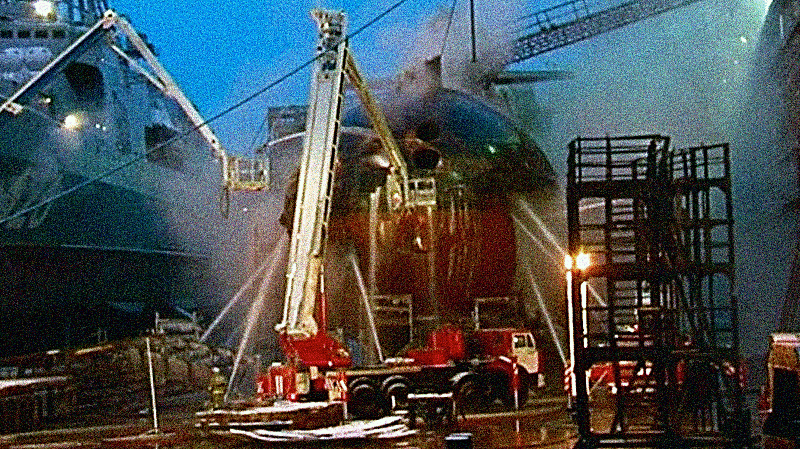
The Yekaterinburg on fire.
The new budget for fiscal year 2013 (which begins on October 1) just released, reports Chris Schneidmiller for Global Security Newswire, calls for the
Energy Department’s semiautonomous National Nuclear Security Administration to receive $11.5 billion [which is] $372 million less for weapons programs than it had anticipated requesting as of 2011.
Most encouraging of all:
The administration aims to freeze development of the Chemistry and Metallurgy Research Replacement complex at the Los Alamos National Laboratory in New Mexico, which would conduct work on materials such as plutonium employed in the U.S. nuclear arsenal. … Under the proposal, funding for the Los Alamos site … estimated to cost up to $6 … would be cut by $165 million and building would be pushed back by no less than five years.
But, as always with nuclear weapons, it’s not long before the parade is rained on. At the New York Times, David Sanger and Alan Cowell report that druing a visit to Iran by International Atomic Energy Agency inspectors “Tehran not only blocked access to a site” — Parchin, to which the IAEA has previously been granted access — “the inspectors believe could have been used for tests on how to produce a nuclear weapon … but it also refused to agree to a process for resolving questions about other ‘possible military dimensions’ to its nuclear program.”
Of course, Iran’s apparent obstinacy may not be due to it’s hiding nuclear-weapons work, but because it feels singled out for the West for persecution. But perception, as they say, is everything:
Iran’s refusal to deal with the inspectors’ questions is likely to increase tension, at a moment of heightened sanctions and after the assassination of nuclear scientists in Iran and suspected retaliation against Israeli diplomats.
Also, Iran bridling at the IAEA’s probing comes on the heels of Iran halting oil exports to Britain and France. Also reports Bloomberg, “Iranian state-run Press TV said yesterday 3,000 ‘new- generation’ Iranian-made centrifuges were installed at its main uranium enrichment site at Natanz.” Though State Department Spokeswoman Victoria Nuland said that — Bloomberg again — “the announcement was ‘hyped’ for a domestic audience.”
But, in addition, as Sanger and Cowell write, Iran also
… struck an increasingly bellicose tone on Tuesday, with an Iranian official warning that the country would take pre-emptive action against perceived foes if it felt its national interests were threatened.
Iran aside, the Dec. 29 fire on Russian nuclear sub Yekaterinburg, undergoing maintenance at the time, might have been more serious than previously thought. Gleb Bryanski of Reuters reports:
At the time, the Russian Defense Ministry claimed the strategic missile submarine had been unarmed as is required for upkeep activities and that there was no danger of radiation exposure to the public.
But Russian Deputy Prime Minster Dmitry Rogozin
… noted that Soviet rules from 1986 do not mandate the unloading of weapons from submarines for small maintenance projects.
Worst-case scenario:
The prominent news magazine Vlast earlier this month reported that the blaze could have triggered … explosions in the submarine’s two atomic reactors and possible detonations of 16 nuclear-armed missiles.
A telling clue that nuclear weapons might have been aboard:
The submarine traveled to the Russian navy’s arms depot directly after the fire, which would not be normal for an unarmed vessel that had just been through a fire, according to the magazine.
Important as preventing nuclear proliferation is, it must always be preceded in importance by nuclear risk. Which means it’s at least as incumbent on states with nuclear-weapon programs to wind theirs down as it is to keep other states from proliferating.

